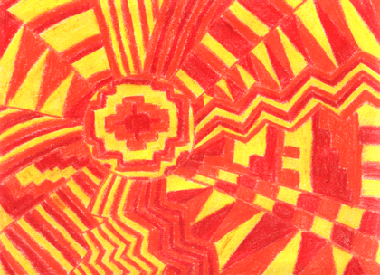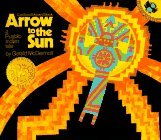 Classroom Crafts
Classroom Crafts
by The Teachers.Net Community
Arrow to the Sun Activity
 by Barb Gilman
by Barb Gilman
Project: Art activity using the book Arrow to the Sun by Gerald McDermott.
Objective: Warm Colors, Angular Shapes, Straight Lines
Medium: crayons
Materials: 8 1/2 by 11 inch white construction paper, 3 warm color crayons
Background: When looking around the natural world, artists may use colors that give a warm feel. These colors may include red-violet, red, red-orange, orange, yellow-orange and yellow. Lines may be straight. Shapes may be angular.
Procedure: The teacher will begin the lesson by reading the story Arrow to the Sun by Gerald McDermott.

Arrow to the Sun: A Pueblo Indian Tale
by Gerald McDermott
$6.99 from Amazon.com
More information
While reading the story, take time to point out the beautiful illustrations. After reading the story, discuss what colors and shapes were used in the story.
What colors are considered warm?
What makes a line straight?
What makes a shape angular?
At this point, each student picks out 3 warm color crayons to use. Each child is then given a white piece of construction paper.
The student begins by drawing a circle, anywhere on the page, with one of their warm color crayons. This circle may be in the middle, the right or on the left side of the paper. From this circle, they will draw lines radiating from the circle. They will then fill up the whole area with lines, angular shapes and designs. The goal is that the sun and each ray will be filled with unique designs. At this point, the teacher may refer back to the book to show the type of designs Gerald McDermott used.
Technique to explore: When coloring very hard and fast, the students may notice that their colors 'sing'! After the project is complete and no white space is left on the paper, the student may take a tissue and rub it over the entire paper to make it very shiny.
Optional: While the students are working on their project, Native American music can be played. Or Native American storyteller tape, such as The Boy who Lived with the Bear as told by Joe Bruchac.
Impressionist Painting
Susan Nixon
2nd Grade
Phoenix, AZ
In preparation for our visit to a Monet exhibit in Phoemix, I had our retired art teacher come in to do some special projects with my second graders. She had prepared quite a few things for teaching at the museum.
I just had to share this first one, because anyone can do it, and it was fabulous! You might want to give students a little background on impressionist painting - painting what you feel instead of exactly what you see. Monet painted his garden at Giverney many times, including his Japanese bridge, the rose trellis, the lily pads, etc.
On fingerpaint paper, the students draw with pencil, putting in the major things they want to show up. Then the students use markers to color in everything - don't color things solidly. If it's water, make it go only side to side.
On 12 x 18 paper, spray water (just from a squeeze bottle thing), smooth the water over all the paper, then put the marker picture face down. Smooth over the back of the paper, peel up and you have a great impressionist painting!
We framed ours in construction paper and displayed them as an art show for parents during conference time.
Check out the latest buzz in the Project Center...
| 
